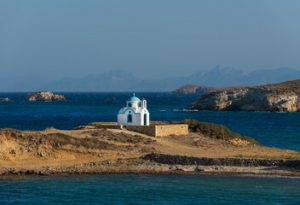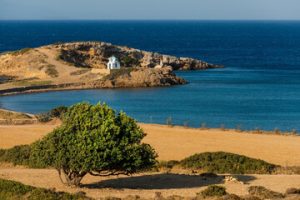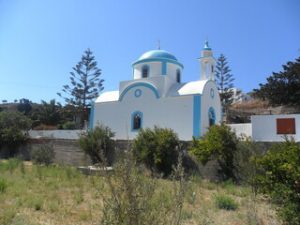Official guide to the island of Lipsi

It should be experienced at a slow pace, without a list in mind of things to see and do. The days here pass serene, admiring rugged hills and enchanting bays bathed by a blue sea, sunbathing on lonely beaches, wandering aimlessly through the cobbled streets of the village. A tiny island, only 8 kilometers long, and sparsely populated: it has only 800 residents, all concentrated in a single village, that of the port of arrival. There are few cars in circulation: you can go around the island on foot, or at most you can take a water taxi to reach the most beautiful beaches.
Large number of visitors concentrated in the two summer months, but the tourist development has not been as tumultuous and devastating as in other islands. The beauty of the island has been preserved thanks to a far-sighted master plan that prevents the construction of buildings over two floors high.
No mega-hotels and resorts, and no huge cruise ships. Since there is little to do other than walking, diving and diving, there is plenty of time to indulge in the pleasures of the island.
Along the small port and at the village at the top of the hill the visitor will find most of the local accommodation in Lipsi , hotels, rooms and apartments. In small taverns and cafes you will find local delicacies.
About Lipsi

It lies between the larger islands of Kalymnos and Samos and benefits greatly from a very large and deep natural harbour and also from being on a main ferry route. Potential visitors can dismiss all the outdated reports of ‘donkey-powered’ Lipsi which suggest there is no motor traffic on the island.
Visitors will be dodging scooters and cars, not donkeys, since the island’s roads were improved thanks to generous dollops of EU cash.
The large harbour has undergone a major revamp to accommodate the many visiting summer yacht flotillas that now make Lipsi a must-visit stopover on any Greek boating holiday route.

The beaches are mainly shingle and sand and all are no more than a narrow waterside strip but all are in walking distance of the main port.
Lipsi has all the oodles of charm and the backwater atmosphere that many Greek holiday visitors expect from the smaller, out-of-the-way Greek islands.
If it’s peace and tranquillity you are after, or fancy yourself as a boat skipper, then Lipsi could be top of on your Greek holiday shortlist.
Lipsi town

The charm is mainly down to an unsparing use of white paint, some lively splashes of colour and a string of shady tavernas around the long quay.
Villagers keep the place spick and span and colourful boats are always moored up, their nets spread to dry on the cement quayside. Lipsi is a favourite port of call for the yachting set so it’s not always quiet but the crowds are occasional and easily avoided.

The blue domed church of Agios Ioannis dominates the hill and it’s worth a climb up the steps for views over the harbour and to visit shops and cafes at almost every turn in the narrow alleyways.Charming, peaceful and unhurried; it may not be pretty but for peace and quiet Lipsi Town is pretty hard to beat.
What to see

The whole town turns easily in just 15 minutes, without anxiety and without haste: it is a destination where the ambitions and the frenetic rhythms of modern life are abandoned and the taste for simple things is rediscovered.
Those who love walking can follow a paved pedestrian street that leads from the Kimisi tis Theotoku church to the temple of Ano Kimisi or reach the Aravis mill at the highest point of the Chora (the historic center of the village).
Springs
Fountani, alias Pikri Nero, in the area near Koimissi along with other minor springs also flowing in this region.
Caves
The Cave of Ontas dominates the settlement. Other interesting geological formations of the kind may be found along the coasts as well as on the islands beyond the bay of the port.
Paths
A 960-meter paved path carved into the hill connects the upper quarters of Koimisi with the lower ones. There is also a Fortress to be found on Lipsi, crowning the uppermost spot of the island.
The views of the Aegean from this vantage point are spectacular. At the highest point of the island are the remains of a castle and the ancient acropolis. It is a very suggestive place, perfect for those looking for a moment of solitude and serenity.
Churches and monasteries of Lipsi
There are several small churches and monasteries scattered around the island. So many are they, in fact, that the saying according to which there is one church for each family in Lipsi might just as well be justified.
Panaghia tou Harou

Once specialists decide to study this construction more closely, there will certainly be some very interesting conclusions drawn referent to the time the church was built (some time between the 7th or 8th Century AC.
There is a holy icon of the Virgin in this church, reputed to be of miraculous powers, depicting Mary holding Jesus Crucified. The uniqueness of the concept and the artfulness of the rendition make of this icon one of the brightest moments in hagiography.
Aghios Ioannis Theologos

Set in a green, endearing landscape, this construction is certain to enchant visitors who often come to quench their thirst at the spring nearby.
Also to be found there: reliquaries containing the remains of monks reduced to martyrdom, slain by the Turks during the dark years of the Ottoman rule.
Five of those monks have recently been beatified by decree of the Greek Orthodox Partriarch.
The church of Panaghia (the Virgin) at Kouselio, built on the very foundations of an early christian church. Embedded in the walls of this church and therefore still to bed seen, are inscription-bearing marbles of that earlier construction that were later used as building material for the new church.

There are many more churches, dedicated to a multitude of saints: one that should not be missed is the church of Aghios Nektarios, built in or about 1980 by father Nikiforos, the parochial priest of Lipsi at the time and a favorite baptistery for the inhabitants of the island.
Where to stay in Lipsi
It is not difficult to choose where to sleep in Lipsi because there is a single town that also corresponds to the only tourist resort on the island.
The hotel facilities are simple but comfortable and well cared for; few hotels, the majority of tourist accommodations are apartments and studios.
The prices are very cheap, far lower than those of the most popular islands. On the other hand, there is a smaller choice of accommodation.
If you travel in July and August it is good to book in advance so as not to risk being sold out. For those who love luxury, Lipsi is not the ideal choice: the best you can find is a 3-star hotel and a couple of charming villas with sea views.
Moving around

The main road runs from Lipsi harbour to Platys Yialos beach, in the north, and to Katsadia beach, in the south, with small branches here and there as it circles the hillside behind the port.
A minibus service often starts up in summer, leaving from a small park in the centre of the harbour and visiting all the main beaches. An island taxi service also operates to those beaches that can be reached by road, or drivers will drop visitors at the start of dirt tracks that lead to various beach coves. The Poseidon Studios sits prominently on the hillside above the ferry jetty in Lipsi Town and has a selection of motor scooters and cycles for hire.
A good road links Lipsi Town to Platys Yialos beach in the north and Katsadia in the south but trips to many other beaches must be made on foot, for part of the way at least.
When to go in Lipsi
Lipsi has a typically Mediterranean climate with mild, wet winters and hot, dry summers. In July and August temperatures on Lispi can soar up to 40°C and many beaches have little in the way of shade. Beaches on Lipsi are bare of sunbeds too, so it’s a towel on the sand or shingle for holiday visitors.
For visitors planning a walking holiday then September to October and April to late June are considered the best times to visit Lipsi. The weather in spring and autumn is warm and comfortable either side of the cooler winter period.
Getting there
By Air
There is no airport on Lipsi but the island is so well served by ferries. It means the island relatively easy to get to from several nearby island airports but journeys from the UK usually require an overnight stop on the way. Most visitors will fly either to the island of Samos, in the north, or to Kos, in the south.
Samos International Airport (SMI), just outside the port of Pythagorion, is the nearest to Lipsi but ferry services have become depleted in recent years. It’s easy to get from the airport to the port but visitors usually have to spend a night on Samos before catching a boat the next day.
As well as charter flights to Samos there are five domestic flights daily (three in winter) from Athens and twice weekly flights from Thessaloniki.
Visitors to Lipsi will probably find it easier to get a cheap flight to Kos Airport, to the south, and catch one of the the Dodekanisos Seaways’ catamarans that sail this route daily. However, it’s a two-hour boat journey and it will almost certainly require an overnight stop on Kos unless the plane arrives early in the day.
An alternative route is to take a cheap flight to Athens followed by an internal domestic flight to the nearby islands of Patmos or Leros which do have small airports. It is then a case of catching of of the regular ferry crossings to Lipsi. Travellers will still probably need an overnight stop on the way.
By Ferry and Catamaran

Dodekanisos Seaways has a fast daily catamaran service from Rhodes to Patmos and back which calls at Symi, Tilos, Nisyros, Kos, Kalymnos, Leros, Patmos and Agathonissi during the summer. In winter it by-passes Tilos, Nissyros and Agathoniss.
Blue Star Ferries includes Lipsi on the Piraeus to Rhodes route of the luxury car ferry ‘Diagoras’ which calls in at Patmos, Lipsi, Leros, Kalymnos, Kos and Symi. It runs just one day a week, usually Wednesday and usually arrives at Lipsi in the early hours.

The Anna Express, for example sails from Lipsi to Kalymnos, Leros, Arkioi and Agathonisi most days, leaving around 8am and returning around 4pm.
Several small boats also offer summer season day trips to the local islets, notably the five-island cruise aboard the sailing boats ‘Rena’ and ‘Margarita’. Details of sailings are usually posted in the harbour.

